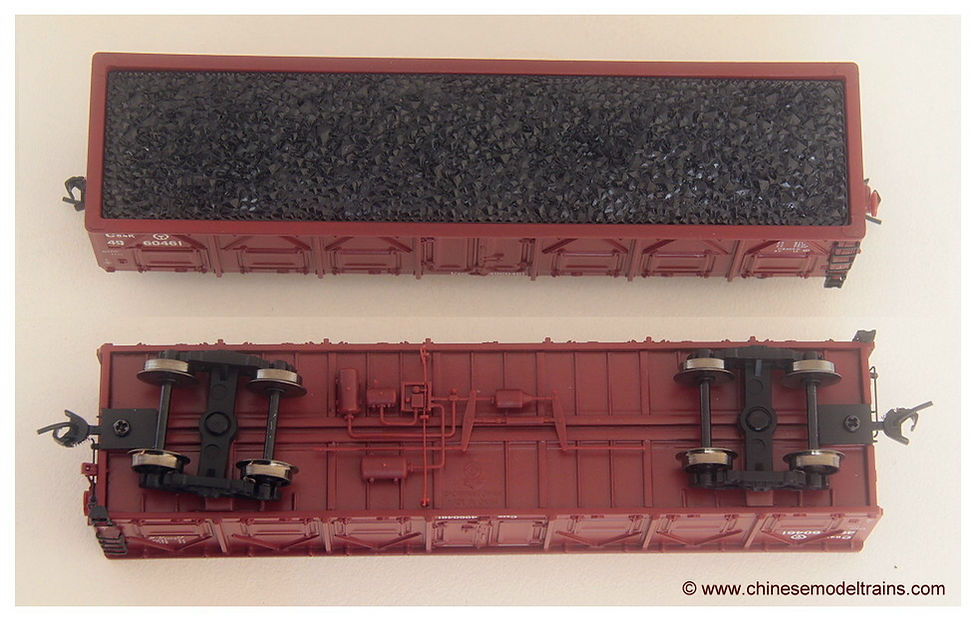
The complete listing of Chinese prototype models is below. For model reviews, please scroll below the table or click here
The complete listing of Chinese prototype models is below. For model reviews, please scroll below the table or click here
The complete listing of Chinese prototype models is below. For model reviews, please scroll below the table or click here
The complete listing of Chinese prototype models is below. For model reviews, please scroll below the table or click here
C64/K
1:87 Scale

Rating
8/10
C64/C64K Class Gondola
Bachmann China
Prototype Information
The C64's are THE freight car in China. Thousands upon thousands are used in everything from coal transportation, to container service. By and large they replaced the majority of their C62 predecessors, but this has been a slow process as the country is often faced with car shortages. They can be found on basically every standard gauge line in China and are used to haul just about any type of product such as timber, coal, steel, manufactured products and are often seen in container service as well where they are able to hold a single 40' or a pair of 20' containers. The more modern C70 family of gondolas have been in service for some time, but it seems the C64's will be around for quite some time yet.

General Information
The C64's are a very welcome addition to the Chinese model railway world, they are very nicely built cars, with very crisp paint work, lettering and physical details. The shell is a single plastic casting. There is a metal weight attached to the bottom side which is completely covered by a floor. The car details are plastic, however ladders are made of metal. The wheels are machined brass chemically darkened.
The first production run were all oxide in colour with removable plastic coal loads. The second run were the same but black. The third and most recent, was offered with black or oxide livery and with containers or a sand coloured stone load. The containers were also sold separately at the same time of their release.

Packaging
The C64's come in a two piece plastic cradle which slides inside a thin cardboard box with display window.
Details
Asides from the livery and sometimes the load on certain versions, the design of the Bachmann C64's have remained unchanged since their first production run. Included in the box to be added are a pack of tarpaulin hooks which fit inside the tiny holes that run along the top lip of the wagon. These require extreme patience and I would recommend a tiny amount of two part epoxy or super glue is applied into each hole with a pin head and then the hook placed in. A plastic cement is useless as the hooks are made of metal. I find the dimensions of the car to be correct, asides from the top edge of the wagon which is bit on the thick side. The is possibly an engineering compromise to avoid a body warp and it can be disguised somewhat by weathering or a coal load etc.

The loads are removable and more weight can be added if you wish. The coal load versions come with a small bag of real coal to glue onto the plastic coal load if you wish. There is no such provision for the stone loaded versions of the third production run. container versions simply sit inside and there is a small thin sheet of protective foam to protect paint damage during transit.

The differences between the C64 and C64K relates to the bogies, the K version (K = 'Kuai', or fast) and rated to run at 120kph. There are slight physical differences on the bogies of the real wagons, but unfortunately bachmann haven't reflected this on the model and they all use the same type. The plastic bogies are attached to the wagon with a pin. Wheels are chemically darkened, and they can be removed from the bogie by gently parting the bogie side frames gently. Be careful if removing the bogies from the body as the pins are susceptible to being bent out of shape and will refuse to clip back onto the shell.

Performance
The cars have a nice weight and roll very freely. The deep wheel flanges don't like Peco code 83 turnouts, but I think we're all getting pretty used to these shenanigans.
Couplers
Bachmann EZ mates can be replaced with Kadee #53/153 (short shanks), #5/58/158 (medium) or #56/156 (long).